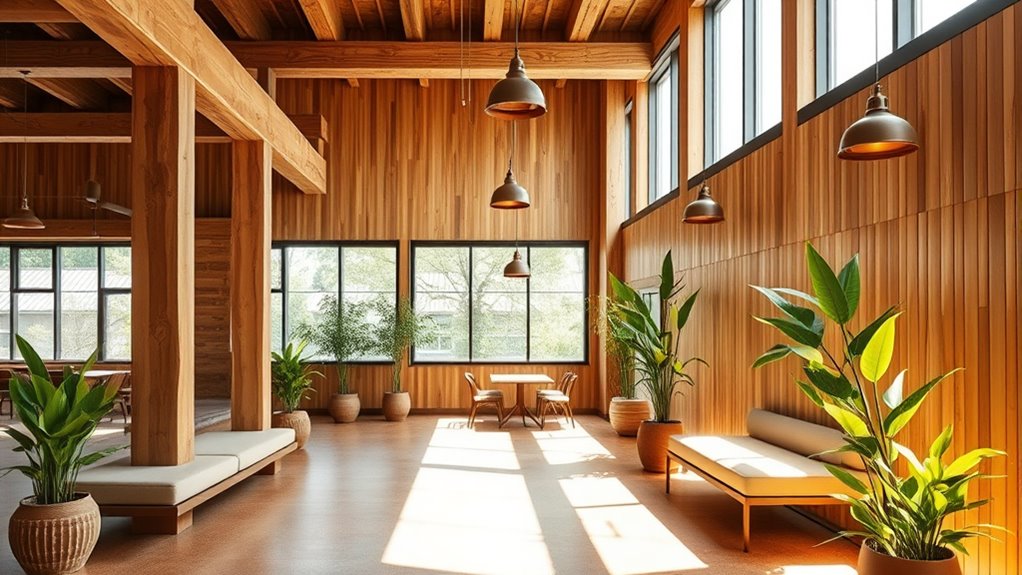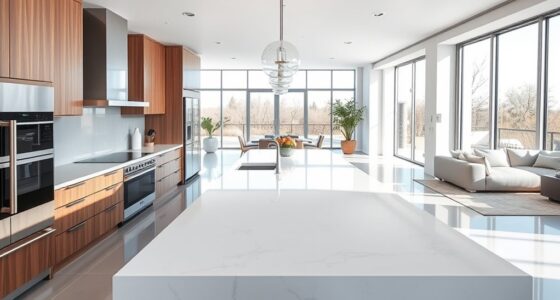To create eco-friendly interiors, you can choose recycled and reclaimed wood for warmth and character, and opt for low- or zero-VOC paints to improve indoor air quality. Sustainable flooring options like bamboo or reclaimed wood reduce environmental impact, while biodegradable textiles and natural coatings support healthier spaces. Incorporating recycled metal or glass wall coverings adds unique textures. If you want to explore more eco-conscious materials and practices, there’s plenty to discover below.
Key Takeaways
- Reclaimed wood and bamboo are sustainable flooring and build-out materials that reduce waste and preserve forests.
- Eco-friendly countertops made from recycled glass, bamboo, or reclaimed wood offer durable, stylish alternatives.
- Low-VOC and zero-VOC paints and natural coatings improve indoor air quality and promote healthier environments.
- Wall coverings from recycled materials like metal, plastic, and glass reduce landfill waste and add unique visual interest.
- Sustainable resource management practices ensure responsible sourcing and minimize environmental impact in interior construction.
Recycled and Reclaimed Wood

Recycled and reclaimed wood offer an eco-friendly alternative to new timber by giving existing materials a second life. When you choose reclaimed wood, you’re reducing demand for virgin trees, helping to preserve forests and biodiversity. These wood pieces often come from old buildings, barns, or shipping pallets, giving them unique character and history. Using reclaimed wood can add warmth and authenticity to your interior spaces, with grains and imperfections that new wood can’t replicate. It’s also durable, often built to last, and can be repurposed into furniture, flooring, or accent walls. By opting for recycled or reclaimed wood, you contribute to waste reduction and promote sustainable practices in construction and design. It’s a simple step that makes a meaningful impact on the environment. Sustainable sourcing ensures that these materials support ethical and environmentally responsible practices in the industry.
Low-VOC and Zero-VOC Paints

Choosing low-VOC and zero-VOC paints is a smart way to improve indoor air quality and reduce environmental impact. These paints emit fewer volatile organic compounds, which means less off-gassing and healthier air for you and your occupants. They’re available in a variety of finishes and colors, making it easy to meet your aesthetic needs without sacrificing sustainability. When selecting these paints, look for certifications like Green Seal or GREENGUARD, which verify their low emissions. Using low- or zero-VOC paints also supports eco-friendly practices by reducing air pollution during application and curing. You’ll find that these paints perform just as well as traditional options, offering durability and vibrant color while prioritizing health and sustainability. Incorporating sound science into product development ensures these paints are both effective and environmentally responsible. Making this switch helps create a safer, greener indoor environment for everyone.
Biodegradable and Natural Textiles
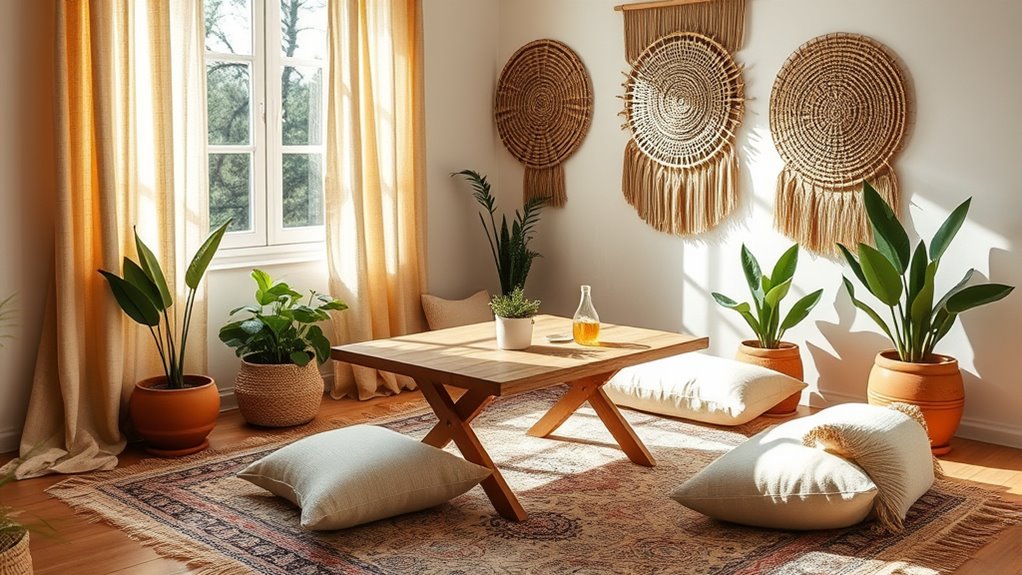
Biodegradable and natural textiles offer an eco-friendly alternative for interior build-outs by reducing environmental impact and supporting sustainable practices. These textiles are made from renewable resources like cotton, hemp, linen, and wool, which naturally decompose without leaving harmful residues. Choosing these materials helps minimize waste and decreases reliance on synthetic fibers derived from petrochemicals. They also improve indoor air quality by avoiding toxic dyes and chemicals common in conventional fabrics. You can incorporate natural textiles into upholstery, curtains, and wall coverings, enhancing aesthetic appeal while prioritizing sustainability. By opting for biodegradable options, you actively contribute to reducing landfill waste and promoting ecological balance. Incorporating sustainable materials into your design not only benefits the environment but also aligns with current trends in eco-conscious interior design.
Eco-Friendly Flooring Options
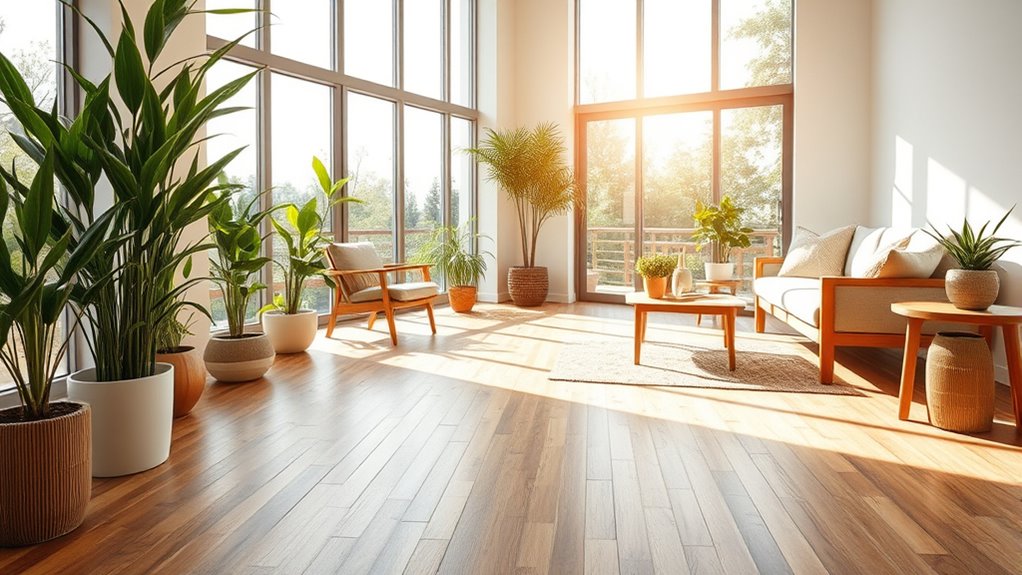
Reclaimed wood and bamboo flooring are excellent eco-friendly choices that reduce environmental impact. Reclaimed wood repurposes old materials, adding character and saving trees, while bamboo grows quickly and regenerates fast. Both options offer durability and style without compromising sustainability. Additionally, self watering plant pots are a sustainable solution for indoor gardening, helping to conserve water and promote healthy plant growth.
Reclaimed Wood Benefits
Reclaimed wood offers an eco-friendly flooring option that combines sustainability with natural beauty. By repurposing wood from old buildings, barns, and mills, you reduce the demand for new timber, conserving forest resources. This process also minimizes waste, giving new life to materials that might otherwise be discarded. Reclaimed wood has unique character, with visible knots, grains, and imperfections that add warmth and authenticity to your space. It’s often more durable than new wood because it’s been naturally seasoned over time. Installing reclaimed wood can also improve indoor air quality, as it typically involves fewer chemicals and finishes. Additionally, reclaimed wood often features distinctive textures and patterns that enhance the visual appeal of your floors. Overall, choosing reclaimed wood supports sustainable practices while providing a timeless, attractive flooring solution that tells a story.
Bamboo Flooring Advantages
Have you considered bamboo flooring as an eco-friendly choice for your interior build-out? Bamboo is a highly sustainable material because it grows quickly—sometimes up to three feet in a single day—without needing pesticides or fertilizers. Its renewability makes it a smart alternative to traditional hardwoods. Bamboo flooring is durable, resistant to scratches, and easy to maintain, making it suitable for high-traffic areas. Plus, its natural aesthetic adds warmth and a modern touch to your space. Choosing bamboo reduces your environmental impact, as it absorbs more carbon dioxide during growth than many other materials. Additionally, low-carb materials like bamboo align with sustainable design principles by minimizing environmental footprint. Overall, bamboo flooring offers a stylish, durable, and environmentally responsible option that aligns well with sustainable design principles.
Sustainable Countertop Materials
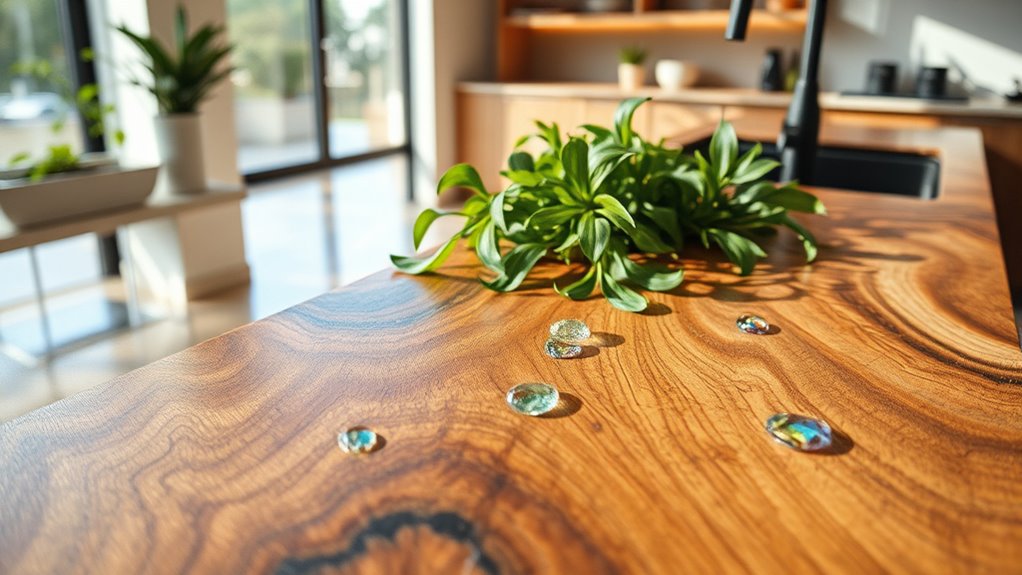
Are you looking for countertop options that prioritize sustainability without sacrificing style or durability? Consider materials like recycled glass, which combines broken glass pieces into stunning surfaces that reduce waste and add a unique touch. Bamboo countertops are another eco-friendly choice, offering fast-growing, renewable material with a sleek appearance. Recycled composite materials, made from crushed stone and recycled plastics, deliver strength and a low environmental footprint. Reclaimed wood countertops bring character and reduce demand for new timber, while concrete options can incorporate recycled aggregates or industrial byproducts. These sustainable surfaces not only support eco-conscious building practices but also provide durable, attractive options for your interior space. Additionally, selecting materials with low VOC emissions can further ensure a healthier indoor environment. Choosing the right eco-friendly countertop helps you create a stylish, sustainable environment that aligns with your values.
Green Insulation Solutions
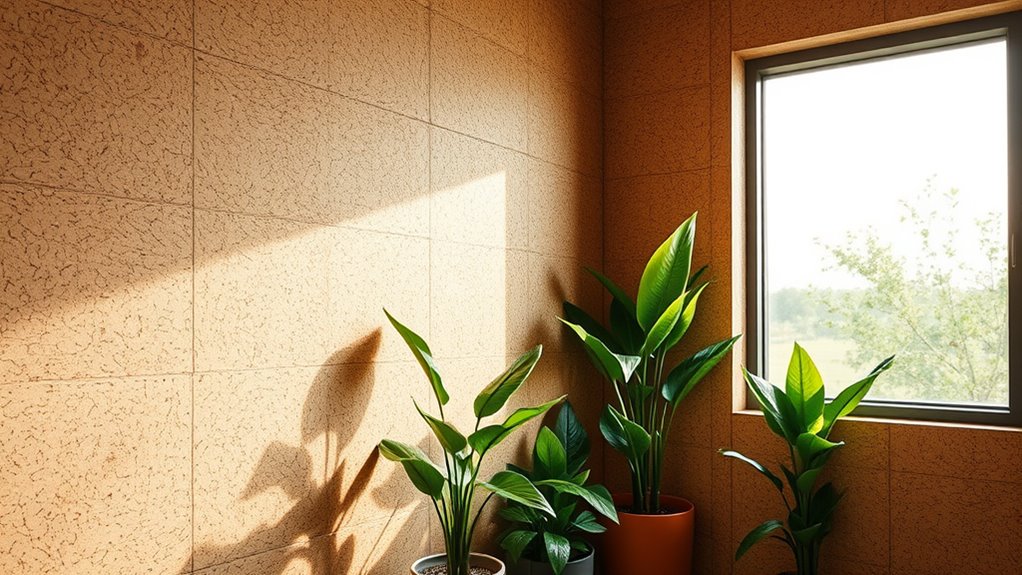
Switching to green insulation solutions allows you to improve your building’s energy efficiency while minimizing environmental impact. These eco-friendly options include materials like cellulose, made from recycled paper, and sheep’s wool, which naturally insulates without harmful chemicals. Spray foam insulation derived from bio-based origins offers high performance with lower VOC emissions. Hemp and cork insulations are renewable, biodegradable, and provide excellent thermal resistance. By choosing these sustainable alternatives, you reduce your carbon footprint and promote healthier indoor air quality. Green insulation also often exceeds traditional materials in durability and moisture resistance, lowering maintenance needs. Additionally, selecting materials that support sustainable forestry helps ensure responsible resource management and reduces environmental impact. Implementing these solutions aligns your project with eco-conscious practices, helping you meet green building standards and appeal to environmentally aware clients.
Innovative Eco-Conscious Wall Coverings
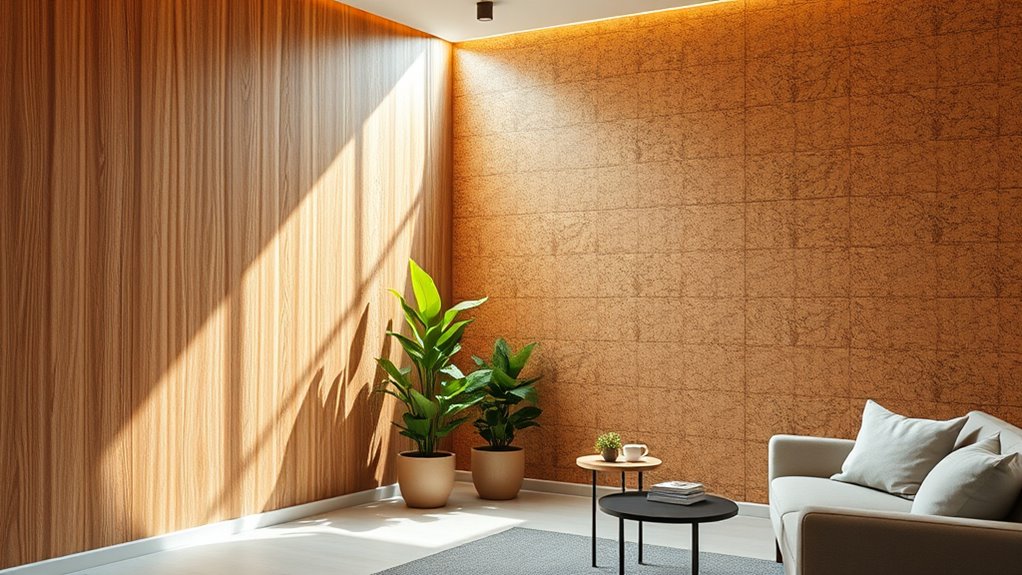
You can choose wall coverings made from recycled materials that reduce waste and support sustainability. Natural, non-toxic coatings offer safe, eco-friendly options that improve indoor air quality. Exploring these innovative solutions helps you create healthier, more sustainable interior spaces and promotes overall mental health through improved living environments.
Recycled Material Options
Recycled materials are transforming interior wall coverings by offering innovative and eco-conscious solutions that reduce environmental impact. You can choose from a variety of options, such as reclaimed wood, recycled metal panels, and plastic-based tiles made from post-consumer waste. These materials not only lower landfill contributions but also add unique textures and visual interest to your space. Recycled coverings often come with durability benefits and minimal VOC emissions, supporting healthier indoor environments. To help you decide, here’s a quick overview:
| Material | Source | Benefits |
|---|---|---|
| Reclaimed Wood | Old furniture, pallets | Sustainability, aesthetic appeal |
| Recycled Metal | Scrap metal, industrial waste | Longevity, modern look |
| Plastic Tiles | Post-consumer plastics | Durability, diverse designs |
| Glass Tiles | Recycled glass | Reflective, eco-friendly |
Additionally, incorporating sustainable materials can enhance the overall eco-friendliness of your interior build‑out.
Natural and Non-Toxic Coatings
Natural and non-toxic coatings are gaining popularity as innovative solutions for eco-conscious wall coverings, offering healthier indoor environments without sacrificing style. These coatings use plant-based oils, mineral pigments, and water-based formulas to reduce harmful emissions like VOCs. They create a breathable, chemical-free barrier that resists mold and microbes, improving indoor air quality. Easy to apply and available in a range of textures and finishes, they suit various aesthetic preferences. Plus, they’re often biodegradable and sustainably sourced, reducing environmental impact. By choosing natural coatings, you prioritize safety, health, and sustainability in your interior build-out. These coatings not only enhance the beauty of your space but also support eco-conscious living, making them a smart choice for modern, environmentally aware design.
Frequently Asked Questions
How Do Sustainable Materials Impact Indoor Air Quality Long-Term?
The current question explores how materials influence indoor air quality over time. You’ll find that sustainable materials often emit fewer volatile organic compounds (VOCs), which helps maintain healthier air indoors. By choosing eco-friendly options, you reduce long-term exposure to harmful pollutants, creating a safer environment for occupants. Over time, these materials contribute to better air quality, lower health risks, and a more sustainable indoor space that supports well-being.
Are Eco-Friendly Materials Cost-Effective Compared to Traditional Options?
Cost considerations create concerns about eco-friendly materials, but you might find that they cost less long-term. While traditional options often have lower initial prices, eco-friendly materials save money through durability, energy efficiency, and reduced maintenance. By choosing sustainable solutions, you’re investing in a cost-effective, conscientious construction that pays off over time. So, yes, eco-friendly materials can be a smart, savvy, and sustainable choice for your interior build-out.
What Maintenance Is Required for Biodegradable Textiles Over Time?
You wonder what maintenance biodegradable textiles need over time. Generally, you should regularly clean them with gentle methods to prevent dirt buildup, which can accelerate degradation. Avoid harsh chemicals that may weaken fibers. Air them out to prevent mold and humidity issues. Over time, some fading or wear might occur, but proper care extends their lifespan. Staying attentive to these details helps keep biodegradable textiles functional and eco-friendly longer.
How Do Recycled Materials Meet Building Safety Standards?
Imagine a world where safety and sustainability dance hand in hand. Recycled materials meet building safety standards through rigorous testing and certification processes, ensuring they’re just as reliable as traditional options. You’ll find that these materials undergo fire resistance, structural integrity, and durability assessments. This way, you can confidently incorporate recycled elements, knowing they contribute to both a safer environment and a greener future without compromise.
Can Sustainable Materials Be Customized for Specific Interior Designs?
You can absolutely customize sustainable materials for specific interior designs. Many eco-friendly options, like recycled wood or reclaimed metals, come in various finishes and styles, allowing you to tailor them to your aesthetic. Work with suppliers who offer customization services, and collaborate with designers to guarantee the materials meet your functional and visual needs. This approach ensures your space is both sustainable and uniquely suited to your vision.
Conclusion
By choosing sustainable materials for your interior build-outs, you’re gently guiding your space toward a more harmonious future. Every eco-friendly choice you make whispers a quiet promise to the planet, reflecting your commitment without fanfare. While these options may seem small, they subtly shape a healthier environment for all. Remember, it’s often the gentle steps that lead to the most meaningful change—your mindful decisions today help craft a better tomorrow.
